October 2. BAHAR DAR "Touring the Monasteries of Lake Tana" It was a beautiful day for our boat ride around Lake Tana. We met the man from the Marine Authority at his office and he walked us through a small park along the waterfront to where the boat was waiting. Our boat driver didn't speak any English but he was a pleasant guy. Before setting out we 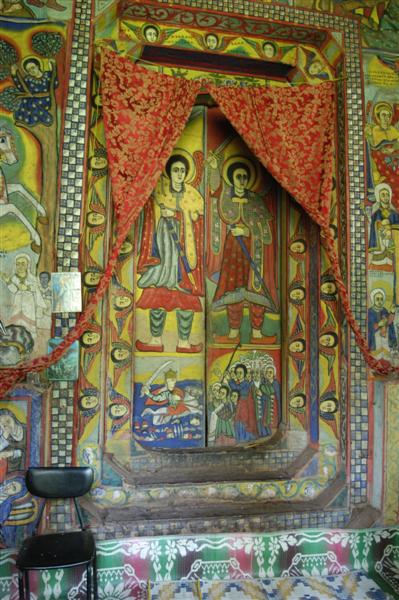 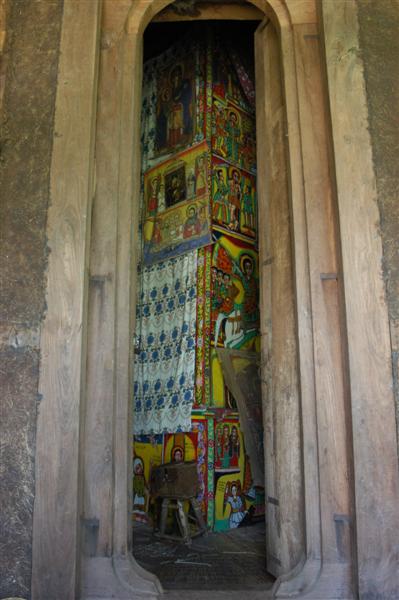 reconfirmed our itinerary, which was a good thing because they tried remove one of the stops from our agreed upon list. It was the farthest stop. We asked the man to produce the list we had written out when we made the arrangements and reminded him that it was part of our agreement. He didn't argue but it was good that we sorted it out before we left because it would have been difficult to straightened it out with our non-English speaking driver. reconfirmed our itinerary, which was a good thing because they tried remove one of the stops from our agreed upon list. It was the farthest stop. We asked the man to produce the list we had written out when we made the arrangements and reminded him that it was part of our agreement. He didn't argue but it was good that we sorted it out before we left because it would have been difficult to straightened it out with our non-English speaking driver.
Lake Tana is a vast lake of 3500 square kilometers and is famous for the many Ethiopian Orthodox monasteries that stand on 20 of its 37 islands. The monasteries date from the late 16th or early 17th centuries but many were founded earlier than than that. Ethiopia is almost evenly split between Muslims and Christians but it is its Orthodox Christianity that had dominated its history. It was the official religion until Emperor Haile Selassie was deposed in 1974 and the second country in the world, after Armenia, to adopt Christianity as a state religion. It is thought to have some roots in Judaism since parts of the country were Judaic prior to Christianity and some elements still existing today indicate a Hebrew influence. But, today most of the remaining Jewish population has emigrated to Israel. Christianity is said to have first reached Ethiopia during the time of the Apostles via merchant travelers that stopped in Ethiopia on their return home to Syria from India. But Christianity did not become a state religion until the beginning of the 4th century and is thought to have been a contributing 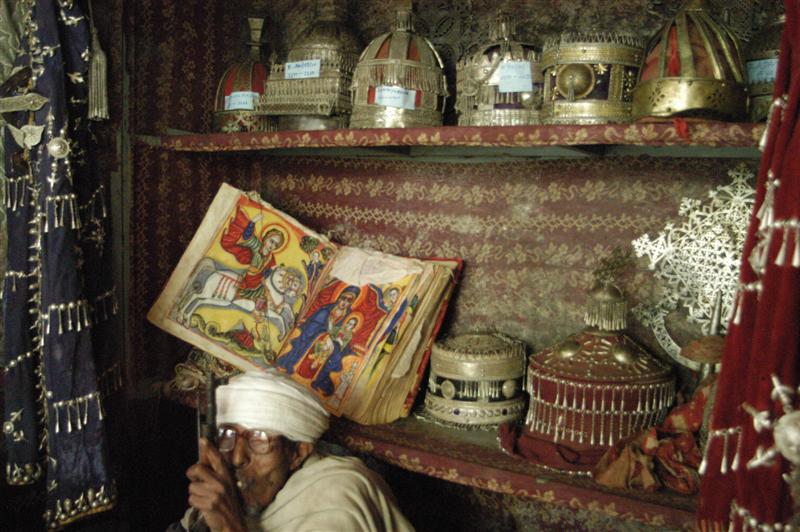 factor to the downfall of the Aksumite empire (refer to our visit to Aksum later). The Ethiopians were the first to mint coins that bore the Christian cross. In the 5th century AD the famous Nine Saints arrived and established monasteries in the north. These Saints were Greek-speaking and it was during this time that the Bible was translated from Greek into Ge'ez, the early language of Ethiopia. factor to the downfall of the Aksumite empire (refer to our visit to Aksum later). The Ethiopians were the first to mint coins that bore the Christian cross. In the 5th century AD the famous Nine Saints arrived and established monasteries in the north. These Saints were Greek-speaking and it was during this time that the Bible was translated from Greek into Ge'ez, the early language of Ethiopia.
Ethiopia's spiritual history is also shrouded in the mystery of the famous Queen of Sheba and her legendary visit to King Solomon of Israel. Ruling from her city of frankincense, on the coast of the Arabian peninsula in present day Yemen, she made the trip to the Israel to bring gifts to Solomon and establish a peaceful relationship between her empire and his. Her journey is documented in the Kebra Negast, Ethiopia's national epic, as well as in the Book of Kings. Her visit is said to have lasted several years and during this time the king and queen maintained a platonic relationship but the king was known for his reputation with the ladies and desired the beautiful queen. They agreed that as long as she took nothing from him, he would take nothing from her. But, at the end of her stay the crafty king had a spicy meal served and left a glass of water sitting temptingly by her bed at night. When she awoke to quench her thirst he caught her and used it as leverage to take something from her. She returned to her kingdom carrying Solomon's son, Menelik. Menelik later visited his father in Israel and made off with the Ark of the Covenant, returning to Ethiopia to establish a dynasty that would last 3000 years.
Our day trip would only take us around the southern tip of the enormous Lake Tana to visit six of the 29 monasteries, four of which stood on the small Zege Peninsula and two on separate islands. Our motor boat was a roomy with just two of us and had a canopy to protect us from the sun. The lake was calm but it took a good half hour to reach the first monastery on the far side of the Zege. We passed a couple of local tankwas, papyrus boats, forging their way across the large body of water. We waived and got smiles and waives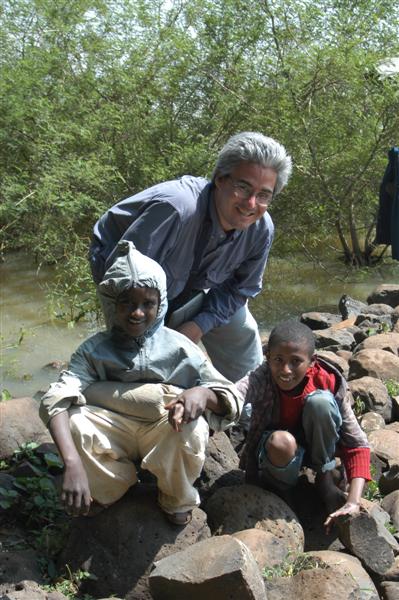 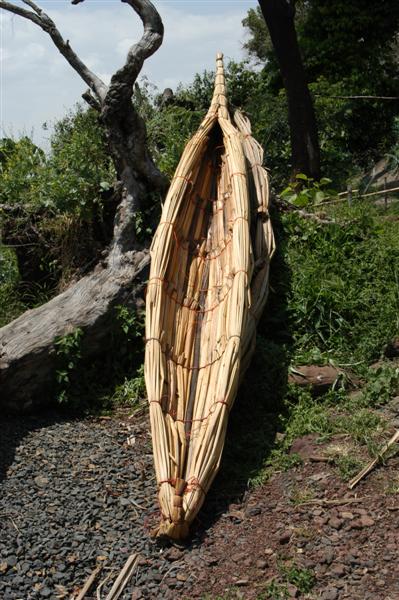 back. back.
The first stop was actually a set of monasteries, Beta Giorgis and Beta Maryam. St. George, the great dragon slayer on his horse, is the patron Saint of Ethiopia. Saint Mary is uniquely revered in Ethiopia and there are many legends and miracles concerning Mary that are little know outside Ethiopia. The churches are said to date from the 19th century or later. Our boat let us off at a small stone jetty and we were immediately greeted by local children, their hands full of things to sell or willing to just take "one birr". Guides were amongst the group as well and we let one lead us up the trail to the first monastery. He was a pleasant young man so we decided to hire him to give us a tour. The key master was waiting on the steps of the monastery while another man collected the money. He tried to charge us double the price quoted in our guidebook but we resisted. The guidebook warned about that and encouraged people to be firm but polite in negotiating entrance to churches in Ethiopia.
The monastery was shaped like a giant tukul, round with a thatched roof, with a set of doors stretching the full length of the wall. The round church is one element that is thought to be Hebrew in origin. There are door facing each of the four directions. The eastern door was reserved for the priests because it opened onto the entrance to the maqda, or inner sanctuary. The southern entrance was for women and the northern entrance for the men. The western entrance could be used by either gender but once inside the men would walk right and the women left. I supposed we entered via the western door but I can't be sure. Once inside our guide led us to the right, around the painted outer wall of the maqda. The paintings were colorful and vibrant, like the icons we saw in 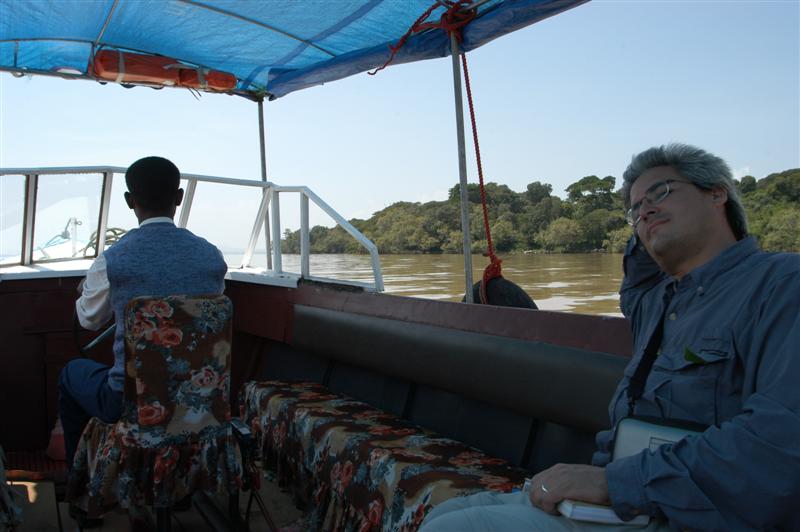 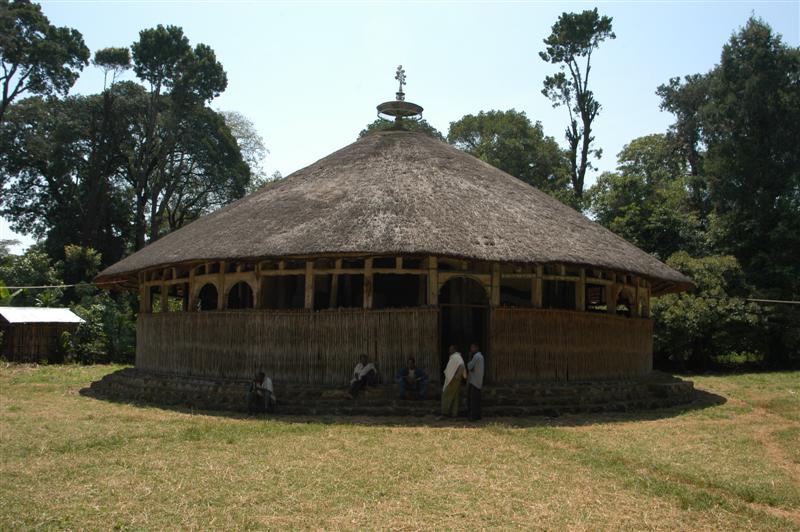 the museum, covering the walls from top to bottom. Once introduced to the images in the first church we began to recognize the pattern. There were many familiar images but also unexpected ones like Belai the Cannibal, a gruesome character that devoured over 72 people before taking pity on a leper who was begging for water in the name of the Virgin. When Belai died Satan claimed his soul. But, as St. Mikael was weighing Belai's victims against the water the Virgin caused the scale to tip in the direction of the water and saved Belai's soul. His devouring image is seen on the wall of the maqdas. There were also some of the lesser known stories about Jesus and Mary in the paintings. One showed Mary scolding Jesus for breaking a clay water jug. He is shown in another image redeeming himself by fixing it. It was a rare image of Jesus as a boy and in a very human light. the museum, covering the walls from top to bottom. Once introduced to the images in the first church we began to recognize the pattern. There were many familiar images but also unexpected ones like Belai the Cannibal, a gruesome character that devoured over 72 people before taking pity on a leper who was begging for water in the name of the Virgin. When Belai died Satan claimed his soul. But, as St. Mikael was weighing Belai's victims against the water the Virgin caused the scale to tip in the direction of the water and saved Belai's soul. His devouring image is seen on the wall of the maqdas. There were also some of the lesser known stories about Jesus and Mary in the paintings. One showed Mary scolding Jesus for breaking a clay water jug. He is shown in another image redeeming himself by fixing it. It was a rare image of Jesus as a boy and in a very human light.
After the second church we were taken to a small museum, really just a large closet, that opened to reveal a collection of crowns. They were beautifully ornate with intricate designs, similar to the ones we had seen in the National Museum. The simple display wasn't really worthy of its precious contents. These crowns were old and too valuable to be so precariously protected in this little closet. There was an elderly armed guard inside but hardly a formidably deterrent to thieves. They claimed it was the best collection after Lalibela. At the end we paid our guide and tipped the others who assisted in the visit and headed back through the trees and coffee plants to our boat.
During our entire tour we resisted the help of a young boy who wanted to guide us back to our boat. He'd been patiently following us the whole way but we were conflicted about 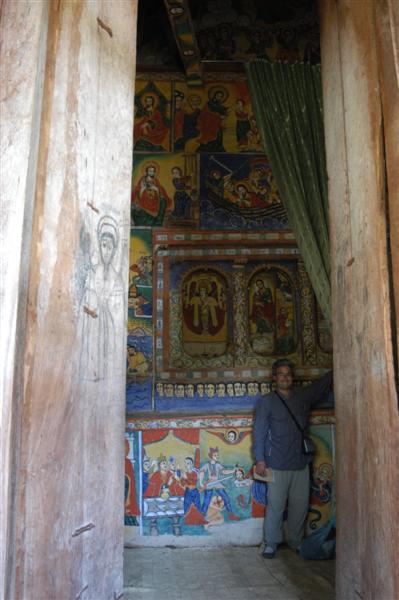 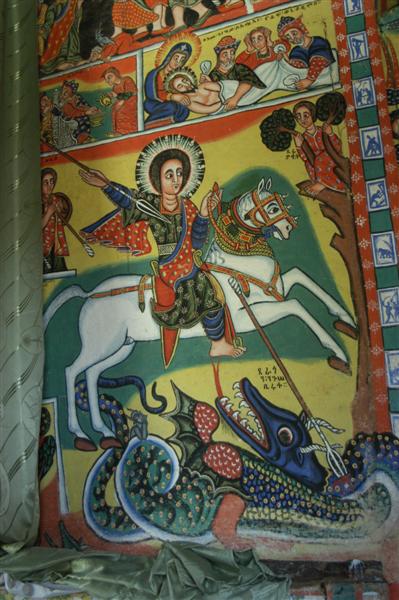 giving money to children. Our experiences in other countries, Mongolia and Morocco for example, told us that giving money to children could have consequences beyond our understanding. But, in this situation the adults at the museum encouraged us to let him take us back to the boat so we did. It cost just a birr and he was a delightful little guy. As our boat pulled away he kept telling us not to forget him. (continued...) giving money to children. Our experiences in other countries, Mongolia and Morocco for example, told us that giving money to children could have consequences beyond our understanding. But, in this situation the adults at the museum encouraged us to let him take us back to the boat so we did. It cost just a birr and he was a delightful little guy. As our boat pulled away he kept telling us not to forget him. (continued...)
|
ADDIS ABABA
Oct 26
Oct 27
Oct 28-29
BAHAR DAR
Sept 30
Oct 1
Oct 2
Oct 2-3
GONDER
Oct 4
LALIBELA Oct 5
Oct 6
AKSUM
Oct 7
Oct 8
Oct 9
ADDIS ABABA
Oct 10-14
|

